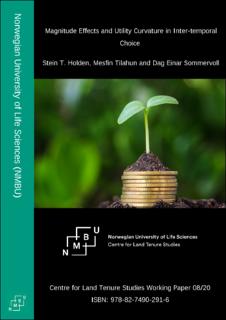| dc.contributor.author | Holden, Stein T. | |
| dc.contributor.author | Tilahun, Mesfin | |
| dc.contributor.author | Sommervoll, Dag Einar | |
| dc.coverage.spatial | Ethiopia | en_US |
| dc.date.accessioned | 2020-12-21T16:44:38Z | |
| dc.date.available | 2020-12-21T16:44:38Z | |
| dc.date.issued | 2020 | |
| dc.identifier.isbn | 978-82-7490-291-6 | |
| dc.identifier.uri | https://hdl.handle.net/11250/2720655 | |
| dc.description.abstract | The appropriate way to empirically estimate time-dated utility and time preferences based on experimental data has been subject to controversy. Our study assesses whether within-subject magnitude treatments are more appropriately modeled through utility curvature, variable asset integration or as magnitude effects in the discounting function. We find that modeling magnitude effects through utility curvature at the same time as allowing for variable asset integration gives theoretically more consistent parameter ranges than including magnitude effects directly in the discounting function. Models with constant discount rates and limited and constant asset integration are rejected. More restricted but variable asset integration gives close to linear utility functions but such models are less robust than a matching fund model which gives a better fit and is robust and stable across multiple samples. | en_US |
| dc.language.iso | eng | en_US |
| dc.publisher | Norwegian University of Life Sciences, Ås | en_US |
| dc.relation.ispartofseries | CLTS Working paper;08/20 | |
| dc.rights | Attribution-NonCommercial-NoDerivatives 4.0 Internasjonal | * |
| dc.rights.uri | http://creativecommons.org/licenses/by-nc-nd/4.0/deed.no | * |
| dc.subject | Assets | en_US |
| dc.subject | Integration | en_US |
| dc.title | Magnitude Effects and Utility Curvature in Inter-temporal Choice | en_US |
| dc.type | Working paper | en_US |

